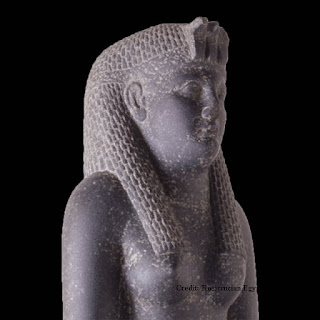domingo, 27 de septiembre de 2020
Head of a block statue
sábado, 26 de septiembre de 2020
cat and kitten
Sculptor's model: Female head in relief
Naked female figure
viernes, 25 de septiembre de 2020
jueves, 24 de septiembre de 2020
Statuette of a woman
miércoles, 23 de septiembre de 2020
Bracelets from the Tomb of King Djer
martes, 22 de septiembre de 2020
Statuette of a woman sitting on a seat
lunes, 21 de septiembre de 2020
Faience figurine
Faience figurine
A bright blue glazed figure of a dancing, dwarfish, lion demon. It has a lionskin headdress, the legs, arms and tail are free-standing, with details picked out in black. The figure probably represents a forerunner of the household god Bes, popular from the early New Kingdom onwards.
Fayence
Esna
Inventory number 03/061/3449
LIVERPOOL MUSEUM
From the 1905 - 1906 excavations of Professor J. Garstang at Esna. The object comes from tomb number 275. This object was donated to the Museum in 1977 by Colonel J.R. Danson a descendent of Sir Francis Chatillon Danson who was a committee member of the Liverpool Institute of Archaeology, and donated funds to Garstang's excavations. This gift included more material from el-'Amarna and Garstang's excavations at Abydos.
Piotr Bienkowski and Angela Tooley, "Gifts of The Nile: Ancient Egyptian Arts and Crafts in the Liverpool Museum", 1995, 77; pl. 121.
http://www.globalegyptianmuseum.org/record.aspx?id=3449
Fertility figurine in unbaked clay
domingo, 20 de septiembre de 2020
Fertility figurine
bull
Large weight in the shape of a bull
The weight is shaped as a crouching zebu with its legs tucked underneath it and short horns. The body has been delicately modelled, and other notable aspects are the details of the face and the rendering of the neck. On the inside, close to the break, is a rectangular field indicating the weight of 20 deben in a bold golden inlay. This means that this bull is the largest metal weight in animal form known to us.
Present location PELIZAEUS-MUSEUM [04/030] HILDESHEIM
Inventory number 6249
Dating 18TH DYNASTY
Archaeological Site UNKNOWN
Category WEIGHT
Material LEAD; BRONZE; GOLD
Technique HOLLOW CAST; INLAID
Height 7.2 cm
Width 6 cm
Translation
"[1] 20"
Bibliography•Eggebrecht, A. (Hrsg.), Gewichte in Tiergestalt aus dem alten Ägypten, Hildesheim - Mainz 1992, S. 7-8, Abb. S. 5, S. 6.
•Eggebrecht, A. (Hrsg.), Pelizaeus-Museum Hildesheim : Die ägyptische Sammlung, Hildesheim - Mainz 1993, Abb. 49.
•Seidel, M., Ein neues Gewicht in Rindergestalt, in: Kessler, D. & Schulz, R. (Hrsg.), Gedenkschrift für Winfried Barta (Münchener Ägyptologische Untersuchungen 4), Frankfurt 1995, S. 353-354, Tf. 1.
globalegyptianmuseum.org
Naos with Statue of a Woman
erotic figurine
viernes, 18 de septiembre de 2020
Standing Woman
Standing Woman
Period:Early Dynastic PeriodDate:ca. 3100–2649 B.C.
Geography:From Egypt, Northern Upper Egypt, Abydos, Osiris Temple, Chamber M69,
Egypt Exploration Fund excavations, 1903Medium:Ivory
Dimensions:H. 4.6 x W. 1.9 x D. 1.6 cm (1 13/16 x 3/4 x 5/8 in.)Credit Line:Gift of Egypt Exploration Fund, 1904Accession Number:04.18.50
Met Museum
metmuseum.org
martes, 15 de septiembre de 2020
sistrum
pebble
lunes, 14 de septiembre de 2020
CLOTH/SHROUD
domingo, 13 de septiembre de 2020
Dice
sábado, 12 de septiembre de 2020
Double-headed water bird amulet
Sekhmet
Sekhmet is a dangerous woman. Her name means the powerful woman. She is the goddess of disease and her breath is the hot desert wind. She once tried to kill everyone in Egypt. Granite. From Egypt, 18th dynasty, reign of Amenhotep III, 1390-1352 BCE. The Kelvingrove Art Gallery and Museum, Glasgow, Scotland, UK (loaned by the British Museum).
viernes, 11 de septiembre de 2020
Cleopatra VII
jueves, 10 de septiembre de 2020
Shabti box of Nesnebtauy
canopic jar lid
Canopic jar lid with the head of Amset. The wig is painted in red, the face in yellow and the eyes in black. 3RD INTERMEDIATE PERIOD Inventory number 15747 MUSEO ARQUEOLÓGICO NACIONAL source: globalegyptianmuseum. org Corresponde a la colección de D. Eduardo Toda y Güell, cónsul de España en El Cairo, comprada por el M.A.N. el 15 de Enero de 1887. Departamento de Antigüedades Egipcias y de Próximo Oriente; PEREZ-DIE, MªC; PONS MELLADO, E.
Shabti for Semity
miércoles, 9 de septiembre de 2020
necklace
Wooden bracelet













































